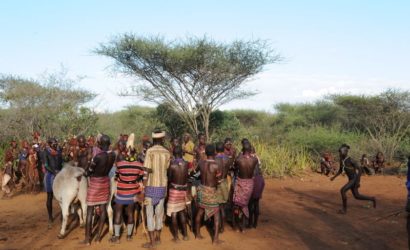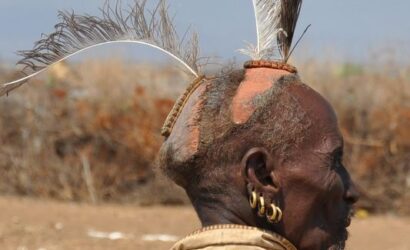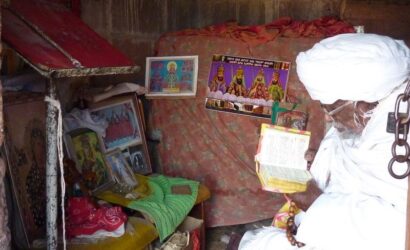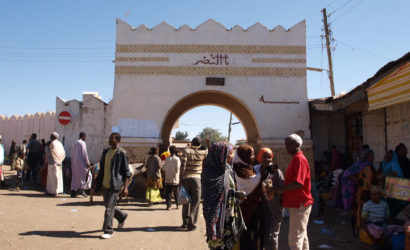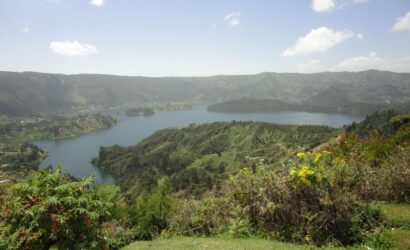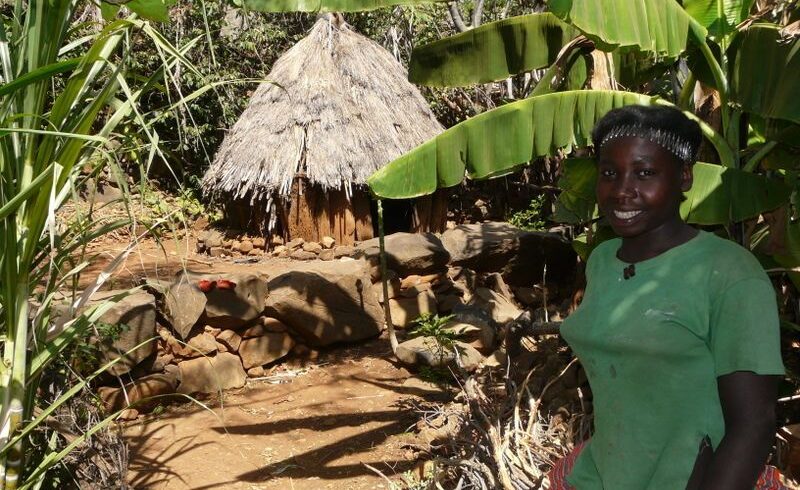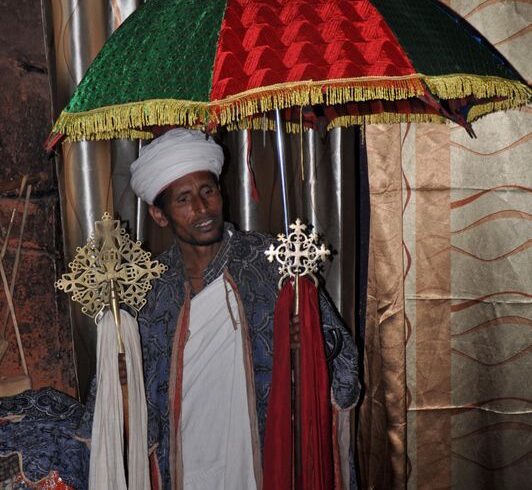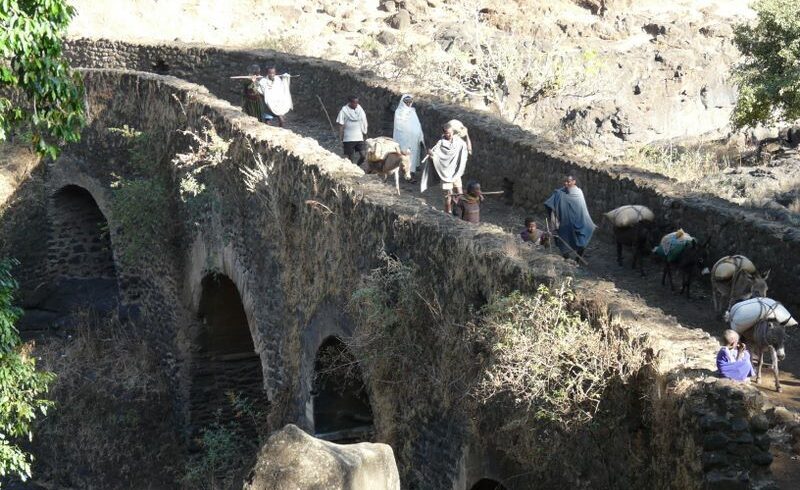This is a fine example of combining some of our suggested itineraries to a ‘Best of Ethiopia’ tour. It is actually a combination of our ’14 days Historical Route by surface” to the north and our ’14 days Cultural South’, complemented with a visit to Harar and Awash National Park in the east. What more do you want?
Itinerary
We will meet you at the airport and take you to your hotel for check-in. The first day we spent in the fascinating capital of the country: Addis Ababa. Depending on your time of arrival we take you on a half-day or full-day city tour visiting some sites of your choice like the Ethnographic Museum, National Museum, Trinity Cathedral, Mercato (the largest market in Africa), or the Entoto Hills just outside Addis Ababa.
After an early breakfast, we leave Addis Ababa for a long drive to the north. The journey leads us through the rolling hills of the Ethiopian Highlands where a lot of agricultural activity is taking place. We will enjoy the natural beauty of the Blue Nile Gorge on the way. Just before sunset, we arrive in Bahir Dar.
Today we have a full-day boat trip on Lake Tana to explore some of the beautiful churches. Before we are heading to the churches the boat takes us to the source of the Blue Nile where we find many water birds and maybe a hippo. It is about one hour by boat to reach Zeghe Peninsula where we visit the most famous church Uhre Kidane Mehret. We enjoy a walk on the forested peninsula to the other churches and might meet monkeys and beautiful birds on the way. On the other side of the peninsula, the boat is waiting and takes us to Kibran Gabriel Island (unfortunately women are not allowed) and finally back to Bahir Dar late afternoon. At the end of the day, we enjoy the panoramic view and the sunset from Bezawit Hill.
(It is possible to visit churches further afield like on Dek Island)
After an early breakfast, we drive for about one hour to reach the small village of Tissisat. Here we enjoy a lovely walk in the cooler morning hours. We cross the Nile by the 17th-century Portuguese Bridge and continue the walk to the falls, meeting local people on the way. After admiring the falls we cross the Nile by small boat to find our car waiting for us. We are heading back to Bahir Dar for lunch and proceed to our next destination Gondar.
We will spend the morning visiting the highlights of Gondar: the Royal Enclosure, Fasilidas Bath, and Debre Birhan Selassie, the church with angel faces painted on the ceiling. After lunch, we proceed towards the Simien Mountains encountering spectacular scenery on the way as good preparation for tomorrow. We enjoy the sunset at our destination the Limalimo Lodge or Simien Lodge.
(budget/ tourist class accommodation is available in Debark, a 45 minutes drive outside the park)
This is a full-day visit to enjoy the natural beauty of the Simien Mountains. There are several opportunities to explore the park, on foot or by car. Depending on your interest and fitness we choose where to go. It is almost guaranteed you see the gelada baboon. The walia ibex and Ethiopian wolf are much more difficult to find.
(it is possible to add any number of days for additional hiking in the Simien Mountains)
A long but spectacular day takes us to Axum. Just outside Debark, we start our first descent down the Italian build Lima Limo road and the rest of the day goes up and down until we finally cross the Tekeze River gorge. The scenery is awesome.
Axum is the place where facts and legends meet. Is the Ark of the Covenant found in Axum? We take you in the footsteps of the famous Queen of Sheba and Ezana, the emperor who converted to Christianity. You will see the spectacular stelae of Axum and visit the Maryam of Tsion churches. (unfortunately, the old church is not open for women). Many more sites are available to visit or you might take a couple of hours at leisure to digest your overwhelming experiences of Ethiopia.
Today we continue our journey through the breathtaking scenery of Tigray. On the way we first visit the Yeha Temple, the oldest structure found in Ethiopia. En route to Mekele, a small detour leads us to the Abreha Atsheba church, one of the best examples of the rock-hewn churches of Tigray.
Instead of one of these places, it is possible to visit Debre Damo, the monastery on the top of a cliff. Only accessible by a 15-meter-long rope and unfortunately for men only.
(it is possible to add additional days to explore more of Tigray)
A long but beautiful drive takes us to the highlight of your visit to Ethiopia: Lalibela. If the day goes smoothly and you feel energetic we might have time to visit Yemrehane Kristos church en route.
The 12th-century rock-hewn churches are the legacy of King Lalibela. It is said his visit to Jerusalem inspired him to build the 11 churches. A full day is necessary to get a good impression of these truly amazing places of worship.
There are quite a few options to spend the rest of our time. For example a visit to the Yemrehane Kristos church or a hike to the Asheton Maryam church. On Saturday there is the weekly market in town. Maybe you want to have some time at leisure too.
(it is possible to add additional days to explore more of Lalibela and the surrounding area, excellent hiking opportunities are available)
After a remarkable visit, we leave Lalibela behind. Today we have two domestic flights to reach Harar. A transfer will take us to the airport, as our driver left already 2 days ago to be on time in Harar. A 45 minutes flight takes us to Addis Ababa and later that day a one-hour flight takes us to Dire Dawa where our driver is waiting for us to take us to Harar. This 55 km journey will take close to 1,5 hr. In Harar, we check-in in at our hotel.
The walled city of Harar is a fascinating town to explore. We take you around through the maze-like layout of this 4th holiest town of Islam. There are many mosques and shrines to discover and it is a lively town too. The Harari market is famous. In the evening we are going to see the Hyena man, feeding the hyena by hand. Do you dare to give it a try?
First, we are traveling through a mountainous and fertile area famous for its coffee and qat and later this day we reach the plains of the Rift Valley and Awash National Park. Late afternoon we go out for our first game drive in de park.
This is a day to explore Awash National Park. Game drives and walks are available to encounter the wildlife and enjoy the scenery. You are likely to see beisa oryx, kudu, defassa waterbuck, Soemmering's gazelle, warthog, and baboon. The park is also a great place for birdwatchers.
(if you want to explore more of the park you might add another day)
With a last game drive, we leave the park behind for our next destination. En route, we stop at Lake Ziway for some birdwatching. If you want we have the afternoon at leisure. However, we would like to take you to Shala-Abiata National Park. These twin lakes offer great scenery and abundant birdlife. Overgrazing by cattle seriously damaged the area and few larger mammals are found nowadays, but it is still worth visiting.
We leave our resort at the lake not too late to have some time available to visit Senkele Game Sanctuary en route. Here we have a good chance to see the endemic Swayne's hartebeest and other savanna animals.
Boat trip on Lake Chamo In about one hour we travel the 28 km from Arba Minch at an altitude of 1400 m to the highland village of Dorze at 2600 m enjoying beautiful vistas over Lake Abaya and Lake Chamo on the way. We visit the Dorze people in their famous beehive-like huts and see the preparation of their staple food made of false bananas. Of course, we try their food. After a relaxing lunch, we depart for a boat trip on Lake Chamo and have a good chance to come up close with most probably the biggest crocodiles you have ever seen. Many (water) birds and hippopotamus are also easily found.
Today we travel further south and traverse the areas where Konso, Tsamay, Banna and Ari people are living. We visit the Thursday market of Key Afar, one of the biggest in the region. Banna, Ari, and Tsamay people travel from far to attend the market. A wide selection of goods and (fresh) produce is sold here and there is a cattle market. After visiting the market we proceed to Jinka.
Today we explore more of the area around Jinka. In the morning we travel into the Mago National Park on our way to probably the most well-known people of the Omo Valley: the Mursi. Don't expect much game on this brief visit to the park. After about a 2 hour drive we reach one of the villages where the Mursi people are living. We are heading back to Jinka for lunch and in the afternoon we visit the Ari people. A big contrast with the morning, Ari people adopted a more 'Western' lifestyle and live on small compounds where they grow a selection of crops.
This morning we first visit the museum at the South Omo Research Centre. Then we proceed to Dimeka where Saturday is market day. As at the other markets, it gets going from the end of the morning. At the market, we find mainly Hamar people but also Karo, Bashada, and Banna travel here. After visiting the market we proceed to Turmi. During our stay in Turmi, we might be lucky to witness an Evangadi dance or maybe even a bull-jumping ceremony.
In the morning we drive 72 km/ 1,5 hr to Omerate on the east bank of the Omo River. This is the area where the Dassanech people are living and we are going to cross the Omo River by local canoe to visit one of their villages. In the afternoon we have another chance to experience the Evangadi dance or the Bull jumping ceremony.
Before we depart for Yabello we enjoy a walk around Turmi to explore the area on foot. When there's no water running in the Keske River (most of the time) we follow the riverbed and find almost certain the black and white colobus monkey and many birds. After the walk, we start driving and we visit an Arbore village on the way. After lunch, we visit the Konso people with their maze-like villages and terraces for agriculture. They are also well known for their Waga stelae, grave markers for the brave and important men of this people. The cultural landscape of Konso is the youngest World Heritage Site of Ethiopia.
We are now in the heartland of the Borana people. They are pastoralists who travel around with their camels and cattle. They are living in semi-arid savanna and with their "singing wells" they provide water for de animals and themselves when water elsewhere is absent. You might be lucky to witness the chain of people bringing the water up, meanwhile singing to keep the spirits up. The crater of El Sod with a salt lake at the bottom offers great scenery and a challenging walk down (and up again) to see the harvesting process of the salt.
Today we leave the semi-arid savanna and enter the green and fertile hills where a lot of the famous Ethiopian coffee is grown. We stay at the Aregash Lodge in Yirgalem situated at a coffee plantation. The lodge is a fine example of an eco-lodge. The huts are built in the same style as the surrounding Sidamo people. Delicious organic, homegrown, food is served in the restaurant. It is a great place for a relaxing afternoon although short walks are available.
On our way to the Bale Mountains, we pass Hawassa where we visit the fish market. The headquarters of the Park is situated in Dinsho and after finalizing the formalities there we enjoy a beautiful walk in the surrounding area. Here we have a very good chance to see the endemic mountain nyala and Menelik's bushbuck. After the walk, we proceed to Goba.
The whole day is spent exploring the Bale Mountains. This is going to be a day of extraordinary scenery and of course, we continue our search for endemic species of which many are found in this area. Among them are the Ethiopian wolf and many birds.
(it is possible to add additional days in the Bale Mountains, for example, to visit the Sof Omar Caves and the area offers great hiking)
We are leaving the mountainous area behind and traveling down to the bottom of the Rift Valley again by a different, very scenic road, via Asela. The last day of your unforgettable visit to Ethiopia brings us back to Addis Ababa. A hotel room for day use is available in Addis. We say goodbye to dear friends with a visit to a cultural restaurant, enjoying the great Ethiopian food together with traditional music and dance from all over this fascinating country. After dinner, we take you to the airport for your flight back home.
(About 115 km (2,5 hr) before Addis Ababa we pass the hot spring resort of Sodore which could make a nice relaxing overnight break if you have another day to spend)


